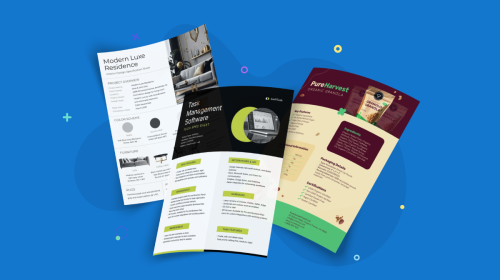
Safety Data Sheet Examples & Templates for Better Workplace Safety


Ignoring workplace safety is gambling with lives.
According to the World Health Organization, occupational chemical exposure accounts for over 800 thousand deaths annually.
That’s a staggering and worrying statistic!
And this is why safety measures in the workplace are non-negotiable.
If you run a factory, laboratory, industrial kitchen or any other place that handles chemicals, it’s your responsibility to keep your workers safe.
One of the most critical actions you need to take is creating compliant safety data sheets. Not only do they make your company compliant, but they can save lives when accidents strike.
Typically, safety data sheets are difficult to read and reference quickly. This can lead to slow reaction times during emergency situations.
In this guide, I'll share several SDS examples and explain why they work, along with a selection of Visme templates to help you create compliant and visually engaging safety data sheets.
A safety data sheet (SDS) is a comprehensive document that provides all the critical information about the hazards of a chemical, product or substance.
It shares information about their properties and guidance on safety precautions. You’ll also find other information, like what to do in the event of a spill or how to transport the product safely.
SDSs are typically written by the manufacturer or supplier of the product or substance and must be provided at the time of sale.
But what types of products and substances need a safety data sheet? In most cases, a safety data sheet is required if the product checks any of these boxes:
According to the International Labor Organization, the control of exposure to hazardous chemicals at work is critical for mitigating health impacts of workers, their families and the environment.
The experts say,
“The first step in a chemical safety strategy for the workplace is to identify what chemicals are present; classify them as to their health, physical, and environmental hazards; and prepare labels and safety data sheets to convey the hazards and associated protective measures. Without such information on chemicals in the workplace or released to the environment, it is not possible to go further in terms of an evaluation of impact and determination of appropriate preventive measures and controls. Information provides the underlying structure needed to achieve the sound management of chemicals.”
Safety data sheets are comprised of 16 standardized sections. This is a universal rule that applies to businesses globally.
See the list below and what each section includes:
Made with Visme Infographic Maker
1. Identification. The substance/product name and other means of identification. Recommended use, restrictions on use, supplier identification (name, full address, phone number, email) and an emergency phone number.
2. Hazardous Identification. The hazard classification of the substance/product. It’s class, category or subcategory, label elements including symbols and pictograms, signal words, hazard statements, precautionary statements and other hazards that don’t result in classification.
3. Composition / Information on Ingredients. For substances: chemical name, common name and synonyms, registry number (depending on region), chemical name of impurities and stabilizing additives. For mixtures: details of each hazardous component, including chemical names, numbers and concentrations.
4. First-Aid Measures. First-aid measures by exposure, such as inhalation, skin contact, eye contact and ingestion. The most important symptoms and effects are either acute or delayed. Necessary immediate medical attention or special treatment measures.
5. Fire-Fighting Measures. Suitable and unsuitable extinguishing measures. Specific hazards arising from the product/substance and special protective equipment and precautions for firefighters.
6. Accidental Release Measures. Information in case of spills and leaks. Personal precautions, protective equipment and emergency procedures, environmental precautions. Methods and materials for containment and cleanup.
7. Handling and Storage. Precautions for safe handling, conditions for safe storage, including incompatible materials and specific end uses.
8. Exposure Controls / Personal Protection. Control parameters like occupational exposure guidelines, appropriate engineering controls and individual protection measures such as protective equipment (PPE).
9. Physical and Chemical Properties. Information about the physical state, color, odor, melting and freezing points, boiling point, flammability limits, flash point, auto-ignition temperature, decomposition temperature, PH, kinematic viscosity, solubility and other relevant properties.
10. Stability and Reactivity. Info on the product/substance’s reactivity, chemical stability, possibility of hazardous reactions, conditions to avoid, incompatible materials and hazardous decomposition products.
11. Toxicological Information. Complete description of toxic health effects and data used to identify those effects, including routes of exposure, symptoms related to physical/chemical/toxicological characteristics, delayed and immediate effects and measures of toxicity.
12. Ecological Information. Exotoxicity, persistence and degradability, bioaccumulative potential, mobility in soil and other adverse environmental effects.
13. Disposal Considerations. Information on safe handling for disposal and methods of disposal, including any contaminated packaging
14. Transport Information. UN number, UN proper shipping name, transport hazard classes, packing group, environmental hazards and special precautions for transport.
15. Regulatory Information. Safety, health and environmental regulations/legislation specific to the substance/product and chemical safety assessment information.
16. Other Information. Date of latest revision of the SDS and any other relevant information, such as training advice or full text of hazard statement.
In section 2, I mentioned symbols and pictograms.
That’s because there’s a universal set of safety visuals that you should use. Here they are:
Here’s an infographic explaining what they are and when to use them.
Made with Visme Infographic Maker
Do you know what a data sheet looks like?
Here are some examples from companies, laboratories and manufacturers. I’ll share what works and what doesn’t for each document.
Nano4Life, a nanotechnology product manufacturer, shares safety data sheets for all their products in a flippable digital booklet. All the SDSs follow a visual style that aligns with the Nano4Life brand.
Not only can you flip through the pages of the SDS collection like you’re holding a book in your hand, the table of contents on the left makes it easy for you to navigate to the particular SDS you’re looking for. There is also an option to print the entire booklet or only the SDS you need.
When you’d need this:
If you’re developing advanced coatings, electronics manufacturing or medical device production, you’ll likely work with nanoparticles. Research facilities, semiconductor companies and biotech startups frequently handle these materials and need comprehensive documentation for each variant.
It’s worth mentioning that when you create an SDS with Visme, share via a link or embed it on your site, it will automatically display with flipbook-style navigation.
This safety data sheet from Airgas, an Air Liquide company, is for solid Carbon Dioxide, most commonly known as Dry Ice. The document outlines the specific dangers of dry ice, including sublimation hazards and proper handling procedures for transportation and storage. The creator of this SDS used two different colors of text to separate titles from information visually. This helps skim the content faster, which is helpful when in an emergency situation.
Who would need this:
In this safety data sheet, 3M displays all the chemical compounds for Glycidyl Azide Polymer. This example illustrates the importance of displaying toxicological information in a clear and clean-cut manner. The alignment and spacing are spot on and should inspire your own SDSs.
Who would need this:
Ricoh’s SDS for print cartridges shows how even common office products may require safety documentation. This example demonstrates how manufacturers address potential exposure risks from toner particles and other components in everyday workplace equipment. I feel that the design on this SDS lacks a bit of order and could have been laid out better.
Who would need this:
Honeywell’s propellant SDS documents proper use and handling of a pressurized substance. It highlights critical information about flammability, pressure hazards and environmental considerations for safe handling and disposal.
This safety data sheet is part of Honeywell’s SDS library, which you can search through for the product you need to reference. Honeywell deals with clients globally, so you can search the library by country and access the latest updated version in seconds.
Who would need this:
Even seemingly non-hazardous products like copy paper may require a Safety Data Sheet for compliance and safety documentation. The reason this SDS for copy paper was made is mentioned upfront.
The Additional Information section highlights: Paper itself does not present a significant health hazard. The dust produced from manufacturing, finishing or handling may cause or aggravate respiratory problems if proper respiratory protection is not used when needed or if exposure limits are exceeded. Accumulation of dust on surfaces may result in fire or explosion in the presence of sparks or flames.
Who would need this:
Selden’s polymer mixture SDS demonstrates how you can lay out complex information in detailed sections. Using the blue color palette, the author/designer assigned a dark hue for titles and a lighter shade for subsections. This technique helps with visual hierarchy and content flow, supporting fast referencing of the SDS details.
Who would need this:
Fisher Scientific’s lead SDS is a great example of how to document highly hazardous substances. This safety data sheet contains comprehensive toxicological information, strict handling procedures and detailed regulatory compliance information.
Something to note about this safety data sheet is that every page has the same header, so you know what substance you’re referencing regardless of what page you’re on. This is helpful when you have multiple SDSs together in a binder and need to quickly find what you’re looking for.
Who would need this:
The last SDS example from MSD is for a controlled substance, in other words, a medicine. The content shows how pharmaceutical products require unique handling procedures and regulatory considerations beyond typical chemical substances. Regarding the design of this safety data sheet, I believe it needs a visual separation between sections, such as a colored box or text.
Who would need this:
Visme designers created a diverse collection of safety data sheet templates. Use any of them to author an SDS for a new product or substance, or to turn a simple manufacturer's SDS into a branded one that aligns with your company.
Use Visme’s Brand Wizard to create your brand kit and ensure consistent colors, fonts and logos throughout all your safety documentation.
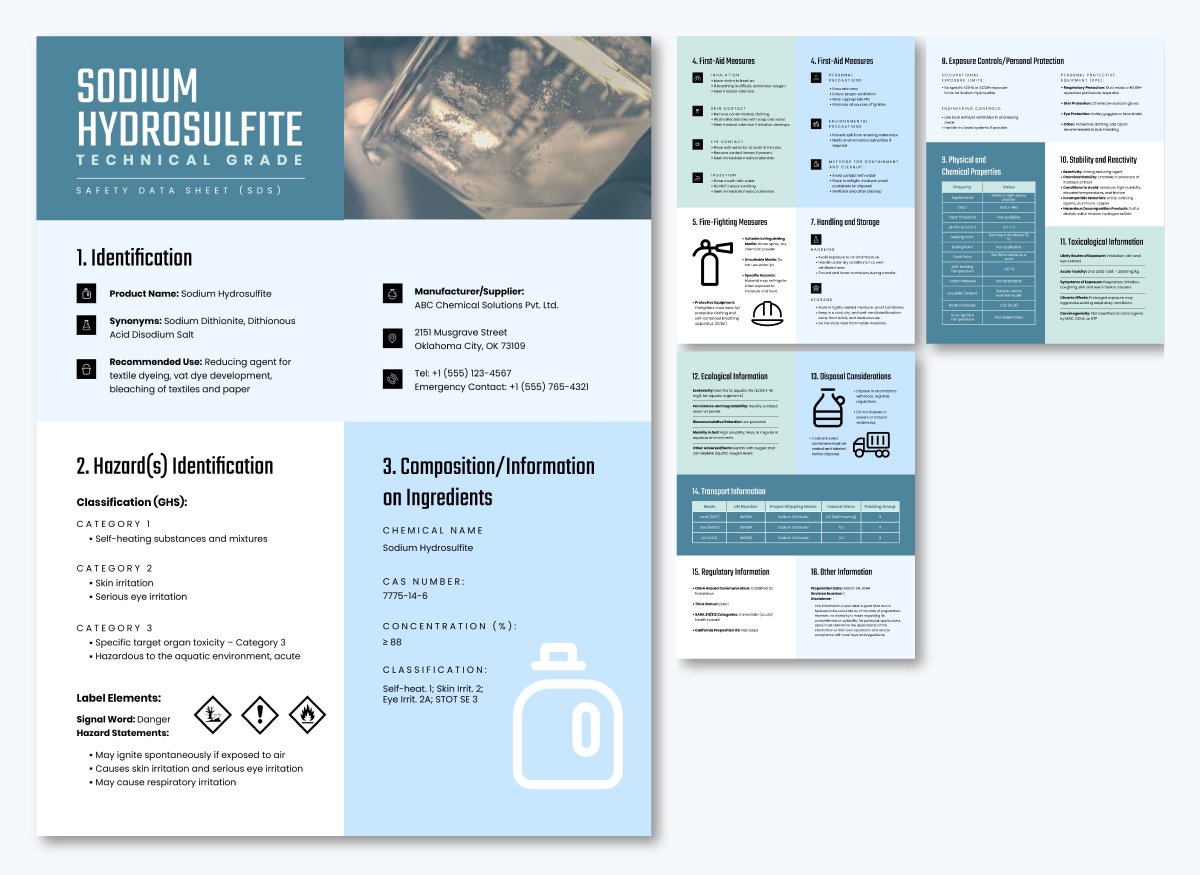
This SDS template for Sodium Hydrosulfite follows GHS formatting guidelines and includes all 16 required sections. It's perfect for manufacturing companies that need to create multiple professional-looking safety data sheets that meet regulatory requirements while maintaining brand consistency.
Use this template to create your branded safety data sheets and leverage dynamic fields to populate recurring company information across all SDS documents automatically.
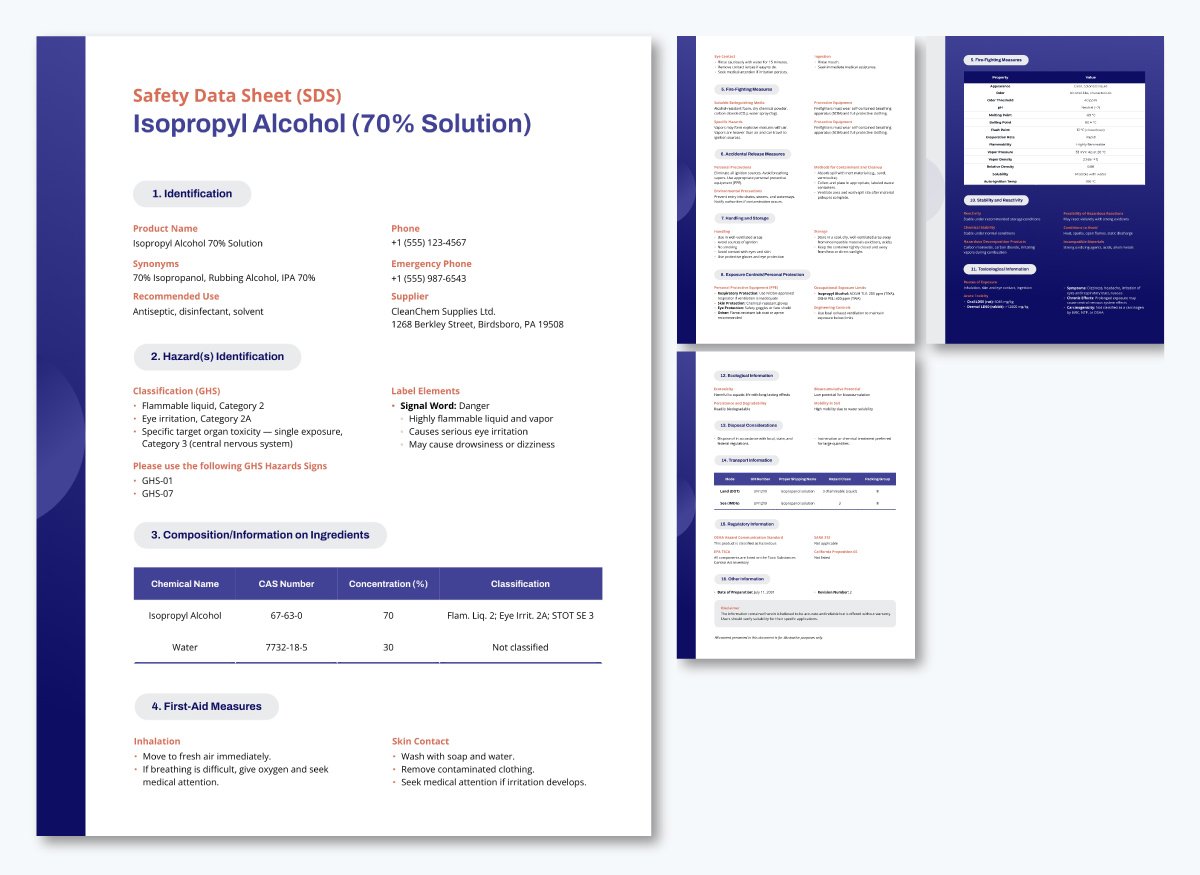
If you’re looking to create a safety data sheet that emphasizes clarity through clean design and a dose of creativity, this template is exactly what you need. It is pre-filled with content for Isopropyl Alcohol, but like all Visme templates, it’s super easy to personalize.
When introducing your own product’s details, enhance the design with Visme’s extensive library of icons, such as hazard symbols and safety visualizations. If you store and share SDSs digitally, consider adding an interactive pop-up with an instructional safety video to each safety icon.
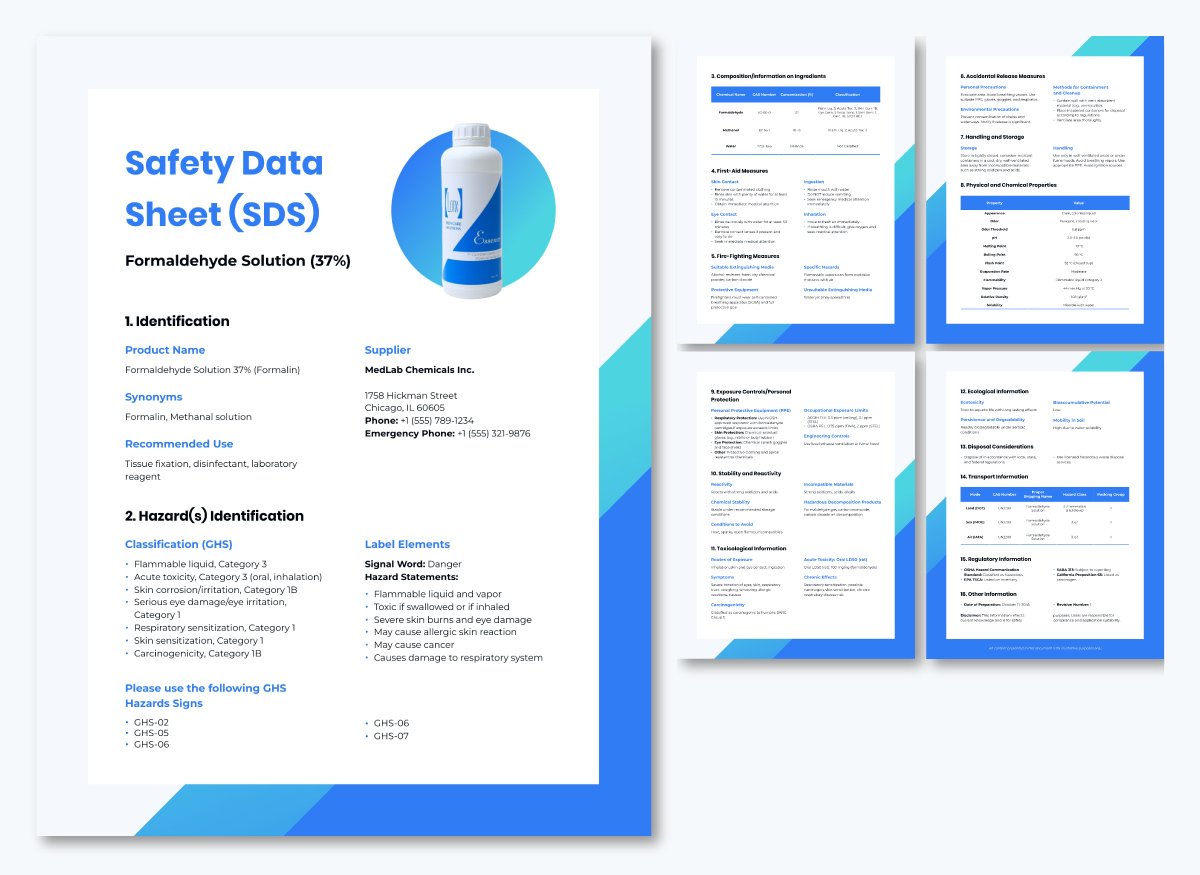
Use this sample safety data sheet to create a document that’s comprehensive and easy to access. The visual tables in sections like the substance composition and physical and chemical properties help readers quickly capture the information they need. In situations involving accidental inhalation or similar incidents, workers must be able to quickly scan the content. The tables in this design support that need.
Safety data sheets are also used as part of instructional materials to prepare workers for those eventualities. All the templates on this list are SCORM and xAPI compatible, making them ideal for organizations that need to track employee safety training and compliance.
Visually rich safety data sheets offer a higher level of communication. This template, for example, incorporates explanatory visuals for the first aid section. Using a visual helps understand the information more effectively, especially when in a hurry to find out what needs to be done in an emergency situation.
If you don’t have any of your own illustrative graphics to include in the SDS, use Visme’s AI Image Generator to help you. In the prompt window, explain exactly what you need to visualize and let AI do the work. When you have an output, write additional instructions in the chat box or regenerate completely if necessary.
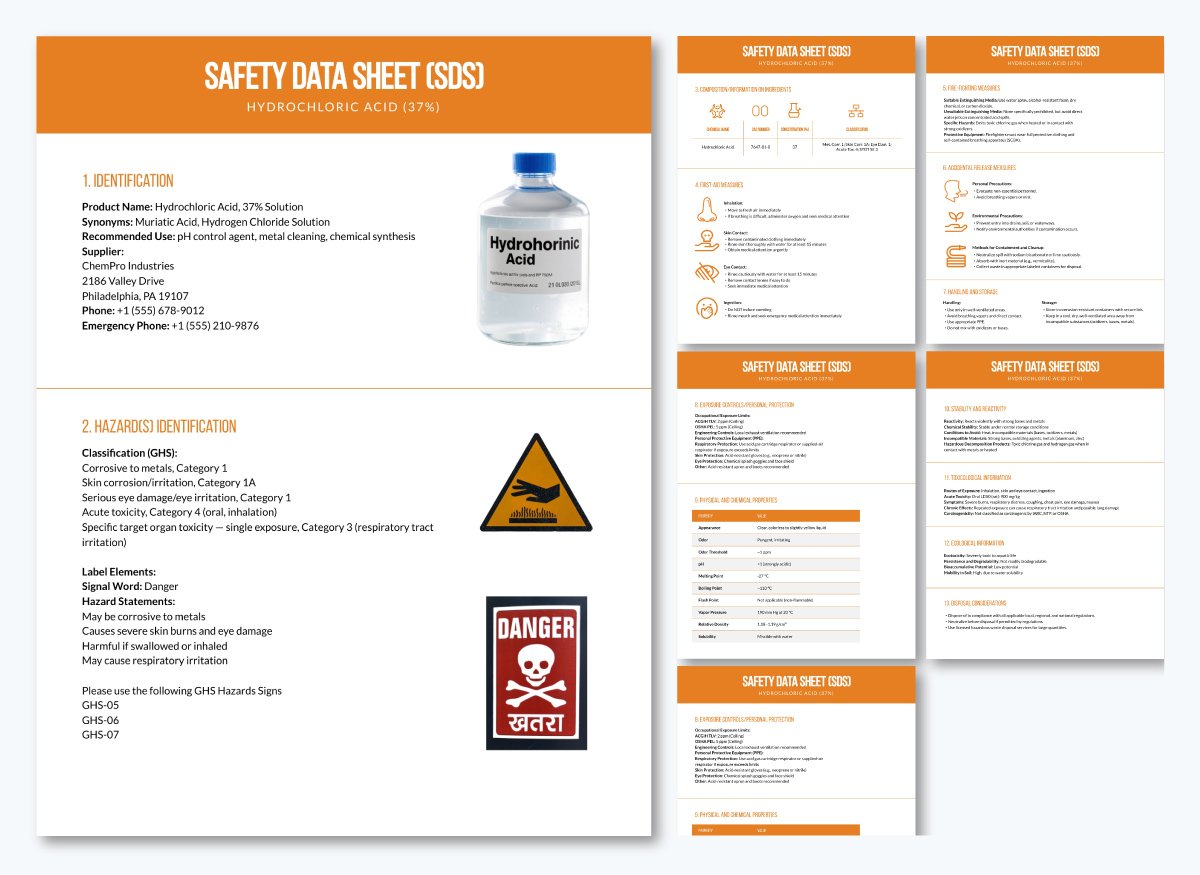
In this chemical SDS, our designers provide space for you to add photos of the actual substance container. This is practical for workers to be able to identify if they’re looking at the right safety data sheet for the product they need to reference.
To achieve this layout, take a photo of the product and upload it to your Visme editor. Place the image in the template canvas and open the AI Edit Tools. Select the background remover and create a cutout of the container. Ideally, show all sides of the product, front, back and sides.
https://my.visme.co/view/j0n8zg7y-visme4-hazardous-chemical-safety-data-sheet
If you’ve created a new product that fits any of the categories below, you’ll need to author an SDS for it.
Likewise, you’ll need to create an SDS if you formulate a whole new chemical to sell as a mixing agent or part of a compound.
Situations in which you won’t need to create an SDS at all are if you’re using substances or products exactly as they came from the manufacturer.
In this case, just file the manufacturer’s SDS as part of your safety stack. Digital SDS management platforms like Chemwatch Backpack will help you keep those SDSs updated by sourcing the manufacturer’s information directly.
So, if your product fits the bill for creating a new SDS, here’s how to do it.
Start by classifying your chemical/substance/product according to the relevant regulations for your target markets. Depending on where you are and who you’re selling to, it could be:
This classification determines not only whether you need an SDS, but also what specific hazard information must be included throughout the document. Identify all jurisdictions where your product will be sold or used, as each may have unique requirements for language, emergency contacts or regulatory information.
In an instructional video by Chemscape Safety Technologies, SDS authoring expert Angela Wheeler, shared a particular situation that proves how important this is:
"One of our clients had SDS written overseas in Asia and they didn't have a sense of the TDG (Transportation of Dangerous Goods), so they had to rework their SDS such that it met Canadian regulations. It's one thing to read a regulation and it's another to be under that regulation you just have a better understanding of what is necessary."
Collect detailed data about your product, including complete chemical composition, toxicological studies, physical properties and any existing regulatory classifications.
Wheeler emphasizes the importance of proper testing before authoring the SDS content: “If you manufacture a product, definitely get tests done so that you can understand the flammability, the corrosivity, the PH, boiling point, vapor pressures, things like that, depending on the characteristics of your manufactured product.”
Consider creating supporting documentation like data sheets and spec sheets to complement your SDS and provide additional product information that stakeholders, employees and workers might need.
Conduct a thorough review to verify that all information is accurate, consistent and current. Wheeler advises that when you receive an SDS back from an author, you should “verify that it makes sense for your organization and your industry. That’s the value you add in the process.”
Check that section 2, the hazard information, matches exactly with what appears on your product labels. Also, double-check your company’s contact information, emergency numbers and any company-specific handling procedures and storage recommendations.
Ensure that emergency contact numbers comply with local requirements. For instance, you might be mandated to include the number of the National Poison Information Center.
Cross-reference your SDS against current regulatory standards for all jurisdictions where your product will be distributed. This includes verifying that your hazard classifications align with the latest GHS revisions and that your transport information meets TDG, DOT, or other applicable dangerous goods regulations.
Compare your SDS with similar products from reputable manufacturers to ensure your classifications and recommendations are reasonable and defensible. This benchmarking process helps identify potential gaps in your approach and validates that your hazard assessments are consistent with industry standards.
Consult with internal experts across departments, including R&D, quality control, regulatory affairs and safety personnel, to gather comprehensive product knowledge and ensure accuracy. Additionally, consider engaging external specialists such as toxicologists and regulatory consultants when dealing with complex formulations or unfamiliar hazard profiles.
Finally, your SDS should reflect your company's actual operations and storage capabilities rather than using generic industry standards that may not apply to your specific situation. This customization ensures that the safety recommendations are both practical and implementable within your organizational context.
With a complete safety data sheet created as a standard text document, it’s time to make it visually engaging with Visme. Sign in to your dashboard and browse our SDS templates. All have been created following GHS formatting requirements and cover all 16 regulatory sections.
Consider starting with Visme’s AI Document Generator to quickly create a first draft based on your SDS text. Open the AI designer, explain in the chat box that you need a safety data sheet and upload the document with the content. The AI will suggest a visual style and put it all together for you.
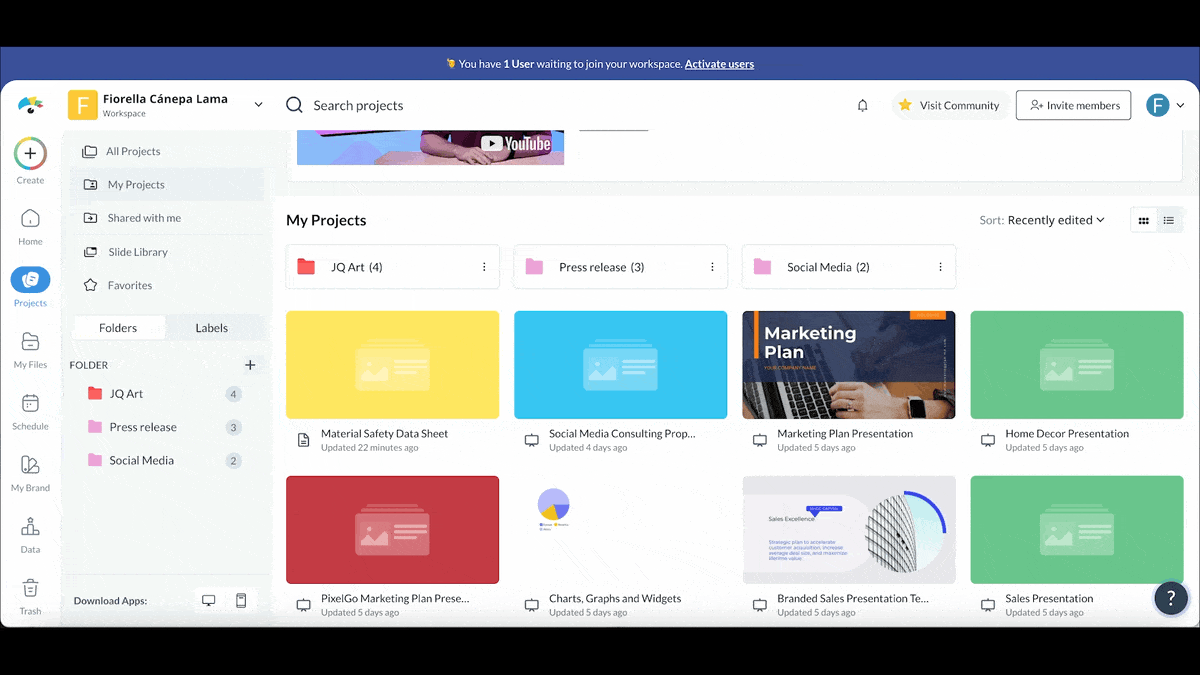
Alternatively, select the template that best matches your industry and carefully transfer all the content from your document into it. Don’t change anything in the text. Be careful when copying and pasting so that you don’t accidentally remove words or sections.
Regardless of which path you took, all text boxes are easily adjustable for size and placement. Use the canvas’s ruler settings to create horizontal and vertical guides, helping you keep text boxes aligned and with sufficient space between them.
Take advantage of our workflow management feature to work on this step along with your team members. You can assign different aspects of the work to any employee in the workspace, like for example one can take care of the branding assets, another can take care of alignment, etc.
Now it’s time to personalize your safety data sheet so it aligns with your brand guidelines and reflects your brand identity. Use your brand kit and brand color theme to apply company colors, fonts and logos throughout the document. This will ensure consistency across all the pages while maintaining a professional appearance and regulatory compliance.
These are some of the things you can optimize in your safety data sheet with Visme:

At this point, you’ll need another review to double-check that everything is correct and all design elements truly serve a purpose with your safety content. Use Visme’s collaboration feature again to streamline the review and approval process using the comment settings for feedback and annotations.
Quality assurance teams, safety managers and regulatory experts can all provide input directly within the platform using comment threads and approval workflows to maintain audit trails. Version control ensures everyone works with the most current information while preserving historical documentation for compliance purposes.
Once your SDS is complete, take advantage of Visme’s share and publish options. Export your document as a PDF for uploading to a dedicated SDS management system, or share via link to maintain interactivity.
If you’re going with self-hosted SDS management, embed all the interactive documents onto your website and set up a library with search functions. Create a QR code for each SDS and print stickers to place on substance packaging or safety stations.
For organizations with safety training requirements, leverage SCORM and xAPI compatibility to integrate your SDS documents directly into learning management systems. Finally, Visme’s analytics dashboard provides valuable insights into document usage patterns (for those shared as links, QR codes or embedded). Track which SDS is accessed most frequently and where it’s happening. The data will help you improve the creation of incident reports and provide insight for improving safety training programs.
Creating safety data sheets isn’t something you can leave to chance. It’s important to be comprehensive, detail-oriented and compliant.
Here are some pro tips to help you check all the boxes towards successful SDS authoring and management.
You can write SDSs yourself, and get help from Visme’s AI Writer too. But this will only get you so far. For 100% compliant documents, it’s in your best interest to assign safety data sheet authoring to someone with the proper credentials and experience.
Remember that SDS compliance is non-negotiable. With so many workers potentially exposed to hazardous chemicals, proper safety documentation saves lives and ensures regulatory compliance across all industries.
Wheeler, one of the first Canadians to earn the SDS authoring designation, stresses,
“I think that competency and SDS authoring is essential and many of our clients have said that too…it’s important for you to understand what a good SDS looks like, specially if you’re in a position to handle those chemicals or approve chemicals.”
So, consider working with a registered SDS author if you lack internal expertise. If you are the expert, then go ahead and write the SDS yourself!
It’s critical that your safety data sheets are always updated with the most up-to-date information. Regular updates prevent compliance gaps and safety risks. Implement effective version control systems to track all changes and ensure the most current version is always available to workers.
Always stay current with regulatory changes by subscribing to updates from relevant authorities, like OSHA compliance guidelines and the UN GHS committee.
Maintain relationships with industry associations that can provide guidance on emerging compliance requirements. Many SDS management platforms typically offer integrated features to help you stay up to date with compliance.
Therefore, if you decide not to use an SDS management service and instead host all your safety data sheets on your website, assign a competent person to regularly update and monitor the current information. They must follow a standard operating procedure and SDS compliance guide so that nothing is overlooked.
Beyond simply providing access to safety data sheets, invest in training programs to help employees understand and apply safety data sheet (SDS) information effectively. Regular training should cover how to locate the SDS they need and how to read the document to find the specific information they require.
Take into account that visual design enhances safety communication. Professional SDS documents with clear icons and visual elements help workers quickly identify critical safety information during emergencies, when clarity matters most. Teach them to understand all visuals, including hazard pictograms so that they can implement safety procedures without obstacles.
Include an SDS training section in your onboarding systems to ensure new hires aren’t left wondering how to deal with hazardous situations. Supplement these lessons with first aid training taught by medical professionals.
Take a look at this example from the JC Ford Company, which conducted a group session to refresh and strengthen knowledge on workplace chemical safety.
For optimal safety compliance, organize a system for SDS storage and retrieval.
OSHA regulations ask that “Employers must ensure that the SDSs are readily accessible to employees for all hazardous chemicals in their workplace. This may be done in many ways. For example, employers may keep the SDSs in a binder or on computers as long as the employees have immediate access to the information without leaving their work area when needed and a back-up is available for rapid access to the SDS in the case of a power outage or other emergency.
Furthermore, employers may want to designate a person(s) responsible for obtaining and maintaining the SDSs. If the employer does not have an SDS, the employer or designated person(s) should contact the manufacturer to obtain one.”
The system must work for all employees, all shifts, in all locations. Options include a digital library, physical binders or a combination of both. The goal is to ensure that workers can access the information they need without delays that could compromise safety.
Learn a thing or two from Karl Neale, a scents manufacturer who shared a personal instance about safety data sheets with me;
“The non-negotiable here is that SDS access has to work for all shifts, including those in the middle of the night or offsite. Delays can cost lives. I once worked with emergency responders who helped review our sheets and spotted weak points we hadn't seen. That was a real eye-opener.”
For storing the SDS documentation, it’s easy to upload a Visme-made safety data sheet PDF to a management platform or online database linked to your website. For training purposes, download SDSs as SCORM or xAPI files and add them to your learning management platforms.
To make retrieval fast, consider implementing QR code stickers on product packaging that link directly to current SDS information, making it easy for workers to access safety data in real-time.
| Overview | Best For | Key Features | Pricing | G2 Rating | |
| Chemwatch Backpack | Cloud-based chemical management platform offering DSD authoring, storage and regulatory tools for global compliance. | Businesses and enterprises that sell/store chemicals or use them to produce or manufacture compounds. | Global regulatory compliance, automated updates, risk assessment tools. | Free plan available. Paid plan prices upon request. | N/A |
| Safety Culture
|
Mobile-first safety management platform that integrates SDS management with workplace safety programs and incident reporting. | Companies with numerous employees across different locations or constantly in motion. | Mobile accessibility, incident reporting integration, customizable workflows. | Free plan available. Paid starts at $24/seat/month | 4.6/5 (146 reviews) |
| Velocity EHS
|
Enterprise-grade environmental, health and safety manangement suite with powerful SDS management capabilities. | Organizations with high EHS risks or that want to improve environmental compliance. | Audit management, regulatory tracking, chemical management, multi-language support. | Upon request | 4.5/5 (114 reviews) |
| Total SDS
|
SDS management and authoring platform. | Small to medium sized companies that need to organize or digitize their safety data sheets. | PDF upload to the Total SDS cloud, SDS translations. | Upon request | N/A |
Yes, there is a globally standardized format for Safety Data Sheets. The Globally Harmonized System (GHS) requires all SDS documents to contain exactly 16 sections in a specific order. This standardization ensures consistency across different countries and industries, making it easier for workers to locate critical safety information regardless of the product’s origin.
The 16 standardized sections are:
Any organization or business of any size that deals with hazardous chemicals needs to have SDSs on file for every substance and compound they deal with. These include any substances that meet GDH classification criteria for physical, health or environmental hazards. Employers must ensure that these sheets are available for workers who may be exposed to these chemicals during normal operations or foreseeable emergencies.
Yes, you can create your own SDS if you manufacture, formulate or import chemicals. However, this requires proper expertise in chemical hazard assessment, regulatory compliance and technical writing.
Many companies choose to work with certified SDS authors or consultants to ensure accuracy and compliance. The key requirement is that all information must be accurate, current and based on reliable scientific data.
Creating compliant, visually appealing safety data sheets is a complex process, not going to lie. But with Visme’s professional templates and design tools like the AI Document Generator, AI Writer and endless amount of visual elements, you can turn regulatory requirements into professional documents that protect your workers while maintaining brand identity.
This guide has hopefully been helpful, regardless of whether you’re just starting to make SDSs or improving existing documentation. We looked at examples, templates and best practices to support your process.
Ready to get started? Get a Visme team plan and help your organization streamline the SDS creation process, one document at a time.
Design visual brand experiences for your business whether you are a seasoned designer or a total novice.
Try Visme for free